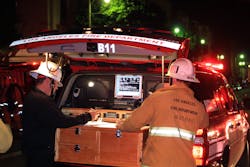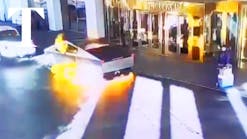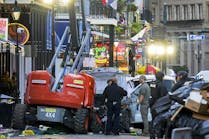When asked about why they got into the business, most firefighters will say it was because they wanted to help people in need. For many of us, whether this was our true reason for choosing this career, the focus quickly shifts to how much fun and how stimulating the work becomes. For some of us, as the years on the job stack up and we become the “old salts” on our departments, we learn to understand and appreciate the importance of the people around us in our careers and lives. This was the case for us as we completed our studies in a career-development program for chief fire officers.
The authors recently graduated from the National Fire Academy’s (NFA) Executive Fire Officer (EFO) Program in Emmitsburg, MD. The program requires a four-year time commitment during which participants attend a two-week course each year at the NFA campus. The coursework covers various aspects of the fire executive’s personal and professional development, including personal/professional development, community risk-reduction practices, emergency operations and the practice of leadership. An additional requirement of each 80-hour course is the completion of an applied research project (ARP) based on both the topic of the course and an issue relevant to the student’s department. While the coursework and associated ARPs are demanding, the program is well worth the time and effort. It is important to note that last year marked the 25th anniversary of the program and since 1985, just under 3,000 fire service professionals have graduated from the program.
The last course, executive leadership, was especially noteworthy because the program director, Chuck Burkell, guided the participants on a tour through the nearby Gettysburg National Military Park. The all-day tour of the Civil War battlefield highlighted many of the 1,300-plus monuments along with the natural terrain that affected the three-day battle strategy and tactics. Burkell also skillfully chronicled numerous critical leadership actions that proved to be decisive both in this battle and eventually in the Civil War. The intent of this activity was to show parallels between the leadership in the July 1863 battle and the challenges facing the modern fire service.
While on the battlefield tour and listening to the stories about those three fateful days, we started to see that the problems of that time are very similar to those we face today. Both sides of that conflict endured miscommunications, self-deception and even egomaniacal behavior, much the same as today. While there were errors in technological assessment, most of the problems involved the people element. An especially interesting “people” story was told in the battlefield story of Confederate Brigadier General Lewis “Lo” Armistead.
Lo’s brigade arrived at Gettysburg in the evening of the second day of battle. Both sides had taken on heavy casualties in the previous two days of battle and General Robert E. Lee was convinced that one more massive offensive assault would overwhelm the Union forces and result in a Confederate victory. Armistead’s brigade would be at the lead of the center of Pickett’s charge in the morning. It wasn’t the fear of the Union’s blazing Napoleon cannons that beset him: What troubled him the most was the thought of reaching the top of the hill and facing his lifelong friend and Union General Winfield Scott Hancock. If he made the hill and encountered Hancock, how could he do harm to his lifelong friend? While not as dramatic as Armistead’s situation, today’s fire service leaders are many times faced with similar conundrums as they transition from firefighter and friend to company officer. Choose friendship or fulfillment of duty? Can we have both? It seems we still have much to learn in this area.
Back in the classroom, however, much of our coursework centered on the topics of adaptive leadership, the traits of leaders and how to develop leadership abilities. We were reminded that leaders need followers and about the importance of motivating people to follow. All of these tips and theories depend on how well we communicate with people. That critical component seems to be the key: the people element.
Another important component of the last course was to develop a personal plan complete with future goals. We were tasked with reflecting, over the course of several days, on our lives and taking stock in where we stood, our beliefs and where we want to go with our future. This activity was not just centered on our careers, but on the holistic view of our lives as they relate to professional, personal, family and community life. Then, with a balanced life-view, we were to write our plan that would chart the future.
For many of us, this process involved a great deal of deep thinking and honest self-assessment. Personal soul-searching prevailed as we exposed our strengths and weaknesses and then completed the forms in the plan. With few exceptions, our plans revealed that we could all be better balanced when it came to the areas of family and even community involvement. That was where the setting of the NFA came into the picture.
The campus of the academy is situated on the south end of Emmitsburg, at the base of the foothills to the Catoctin Mountains of the Allegany Mountain range. The rolling hills are picturesque, tranquil and even calming. Emmitsburg itself is a small town with one busy road going through that is lined with rowhouses and shops right up to the sidewalks. The local volunteer fire department, Vigilant Hose Company No. 6, sits in the center of town, proudly protecting its residents since 1884. On the same road and adjacent to it is the center of the community: the Ott House Tavern.
The Ott House became a natural backdrop to our academy experience for a variety of reasons: It became our stopping point after each of our bike-ride forays into the mountains. And, it was soon obvious to us that it is an important meeting place for the people of the area. In this respect, the Ott House became a needed diversion from our classroom studies and paradoxically became a focal point of the life plans we were writing.
You see, the Ott House is a place where the people of the community meet to talk, to socialize, to eat and to keep in touch with each other. We, as occasional guests, merely breeze in and out every year for our two-week visit as students at the NFA. But in reality, we were fortunate to be a part of the fiber of life of this community for a short while. Why? Because it helped us focus on what we were missing in our lives when we held a magnifying glass up to our own behavior and life activity.
Witnessing how the townspeople would come in every day and interact reminded us that we need to be more a part of that dynamic back home. We came to know some of the townspeople ourselves and interacted with them. We met a young man named Raymond, who came in each day for a glass of sweet tea. He told us of his passion for the fire service and how he relished his service to the Vigilant Hose Company. We saw Larry stop each day to treat himself to a beer. We came to know Clara when she came in to have a glass of wine. We also saw how the owners, Bobby and Susie, watched over these beloved people while we were there. It was readily apparent to us that this special gathering place was so much more than just a business to them.
A recent indication of the Ott House’s role in the vitality of the community was demonstrated after a recent fire directly across the street. As a result of the fire, many residents were displaced, with no place to go. Many were without insurance, so a fund was launched to assist them in their basic, immediate needs. Additionally, Bobby and Susie extended an offer to temporarily house many of the fire victims in apartments above the tavern.
Our last experience at the NFA reminded us that the fire service and the fiber of life are inextricably woven together. We simply cannot have one without the other. It seems we are symbiotic. We depend on one another and we do well to remember that our business is all about serving the public. It took the fine people of Emmitsburg, and the reflection on our life plans, to arrive full circle and recognize that.
The next article in this series will look at methods of employee motivation through traditional means and more innovative and humanistic approaches. It will also detail how the development of your organization’s vision, mission and values can be completed collaboratively.
JOSEPH L. KRUEGER is a 31-year veteran of the fire service and an assistant chief of the McHenry Township, IL, Fire Protection District. He has a bachelor of science degree in mechanical engineering from the University of Illinois-Chicago. DAVID F. PETERSON is a 31-year veteran of the fire service who is an assistant chief of the Milton and Milton Township Fire Department in Wisconsin and a fire officer with the City of Madison. He has a bachelor of science degree in fire service management from the University of Southern Illinois. Krueger and Peterson are graduates of the National Fire Academy’s Executive Fire Officer (EFO) Program and principal partners in White Helmet Innovations. They write a monthly column titled “Leadership under Fire “for www.firehouse.com.
?
Joseph L. Krueger
Joseph L. Krueger, MS, MIFireE, CFO, EFO, is a 34-year veteran of the fire service and is currently a deputy chief with the Greater Round Lake Fire Protection District in Round Lake, IL. He has a master’s degree in executive fire leadership and disaster preparedness from Grand Canyon University and a bachelor’s degree in mechanical engineering from the University of Illinois-Chicago. He is also a graduate of the National Fire Academy’s Executive Fire Officer Program. Krueger is a member of the Institution of Fire Engineers and has a Chief Fire Officer designation. He also has extensive experience in leadership and management in the private sector and is a principal partner of White Helmet Innovations, LLC.






